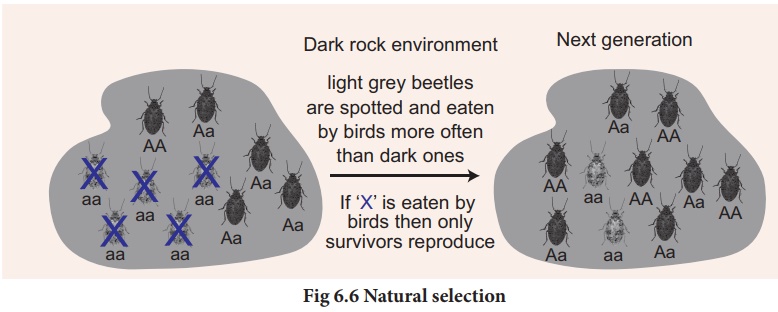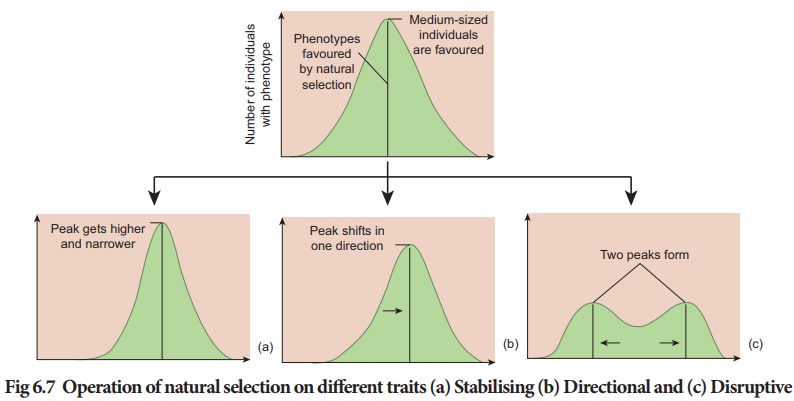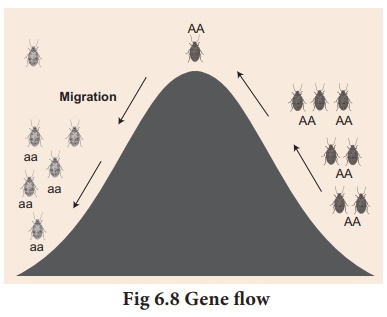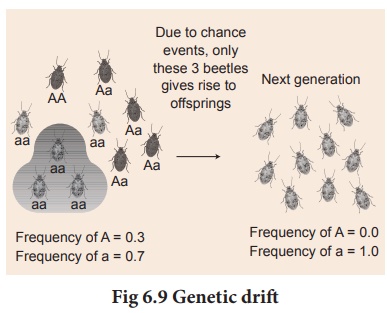Zoology - Mechanism of evolution | 12th Zoology : Chapter 6 : Evolution
Chapter: 12th Zoology : Chapter 6 : Evolution
Mechanism of evolution
Mechanism
of evolution
Microevolution
(evolution on a small scale) refers to the changes in allele frequencies within
a population. Allele frequencies in a population may change due to four
fundamental forces of evolution such as natural selection, genetic drift,
mutation and gene flow.
1. Natural selection
It occurs when one
allele (or combination of alleles of differences) makes an organism more or
less fit to survive and reproduce in a given environment. If an allele reduces
fitness, its frequencies tend to drop from one generation to the next.

The evolutionary path of
a given gene i.e., how its allele's change in frequency in the population
across generation, may result from several evolutionary mechanisms acting at
once. For example, one gene’s allele frequencies might be modified by both gene
flow and genetic drift, for another gene, mutation may produce a new allele,
that is favoured by natural selection (Fig. 6.6).
Selection
There are mainly three
types of natural selection
i. Stabilising Selection
(centipetal selection): This type of selection operates in a stable environment (Fig.
6.7a). The organisms with average phenotypes survive whereas the extreme
individuals from both the ends are eliminated. There is no speciation but the
phenotypic stability is maintained within the population over generation. For
example, measurements of sparrows that survived the storm clustered around the
mean, and the sparrows that failed to survive the storm clustered around the
extremes of the variation showing stabilizing selection.

ii. Directional Selection:
The environment which
undergoes gradual change is subjected to directional selection (Fig. 6. 7b).
This type of selection removes the individuals from one end towards the other
end of phenotypic distribution. For example, size differences between male and
female sparrows. Both male and female look alike externally but differ in body
weight. Females show directional selection in relation to body weight.
iii. Disruptive
Selection (centrifugal selection): When homogenous environment changes into heterogenous
environment this type of selection is operational (Fig. 6.7c). The
organisms of both the extreme phenotypes are selected whereas individuals with
average phenotype are eliminated. This results in splitting of the population
into sub population/species. This is a rare form of selection but leads to
formation of two or more different species. It is also called adaptive
radiation. E.g. Darwin's finches-beak size in relation to seed size inhabiting
Galapagos islands.
Group selection and
sexual selection are other types of selection. The two major group selections
are Altrusim and Kin selection.
2. Gene flow
Movement of genes
through gametes or movement of individuals in (immigration) and out
(emigration) of a population is referred to as gene flow. Organisms and gametes
that enter the population may have new alleles or may bring in existing alleles
but in different proportions than those already in the population. Gene flow
can be a strong agent of evolution (Fig 6.8).

3. Genetic drift / Sewall Wright Effect
Genetic drift is a
mechanism of evolution in which allele frequencies of a population change over
generation due to chance (sampling error). Genetic drift occurs in all
population sizes, but its effects are strong in a small population (Fig.
6.9). It may result in a loss of some alleles (including beneficial
ones) and fixation of other alleles. Genetic drift can have major effects, when
the population is reduced in size by natural disaster due to bottle neck effect
or when a small group of population splits from the main population to form a
new colony due to founder’s effect.

4. Mutation
Although mutation is the
original source of all genetic variation, mutation rate for most organisms is
low. Hence new mutations on an allele frequencies from one generation to the
next is usually not large.
Related Topics